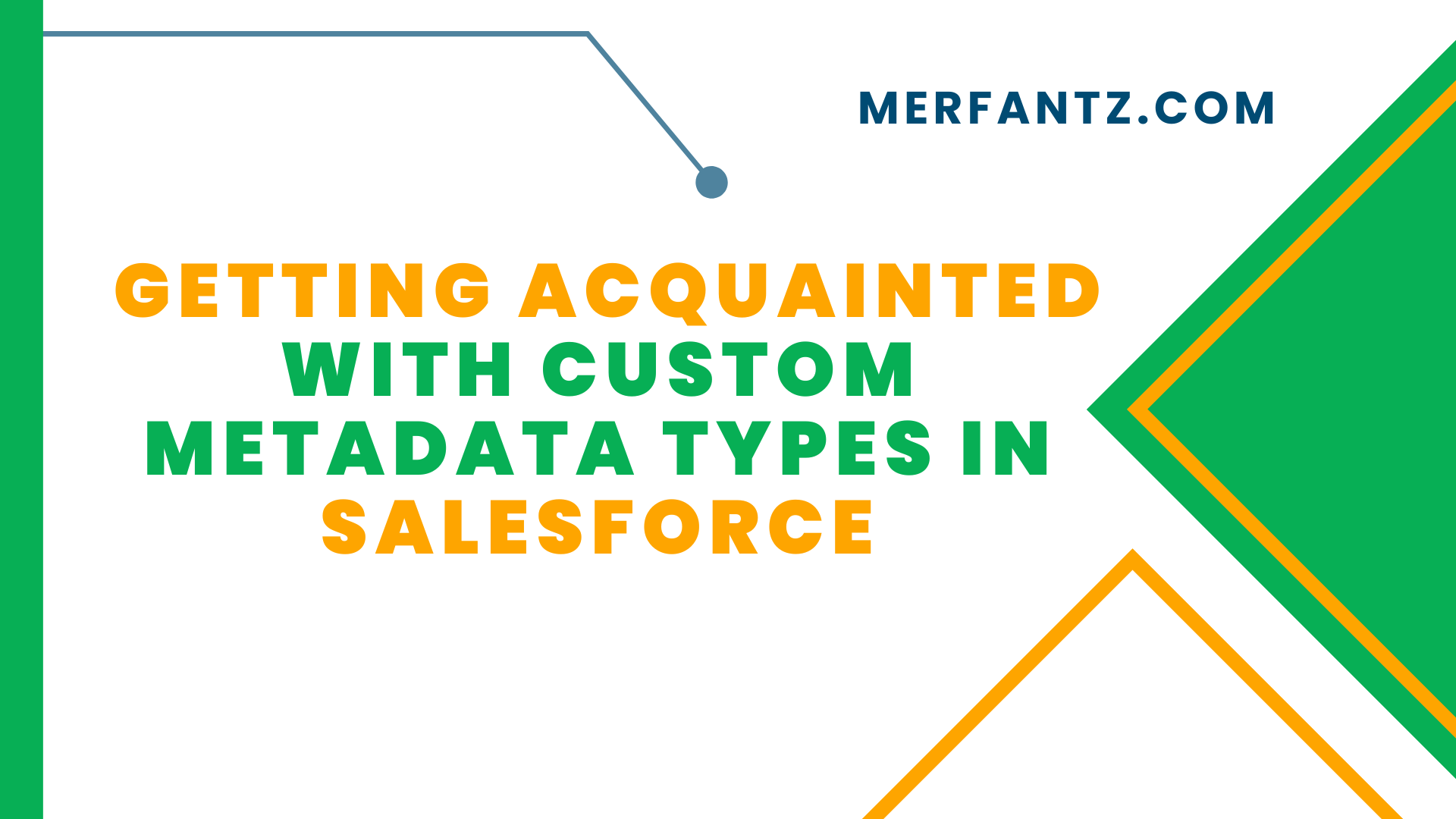Introduction to Custom Metadata Types
Custom Metadata Types hold a pivotal role within the Salesforce ecosystem, transforming the way organizations manage configurations and customize their solutions. These types are like customizable building blocks that facilitate streamlined data management and application behavior customization. In this post, we’ll delve into the significance of custom metadata types, while also highlighting the distinctions between them and traditional custom objects.
Custom metadata types introduce a dynamic layer of abstraction, allowing you to define and manage metadata records that can drive various aspects of your Salesforce applications. Unlike custom objects, custom metadata types are deployable across different environments, making them an ideal choice for consistent configurations in development, testing, and production environments.
Advantages of Custom Metadata Types
One of the primary advantages of custom metadata types is their ability to streamline data management. By storing configurations as metadata records, you can swiftly adapt your application behavior without resorting to code changes. Imagine effortlessly adjusting business rules, user permissions, or application settings, all through altering metadata records – no coding required.
Furthermore, this streamlined approach enhances customization. Custom metadata types empower administrators to make changes directly within the Salesforce setup, eliminating the need for developers’ involvement for minor adjustments. This accelerates the iterative development process, allowing organizations to respond swiftly to changing requirements and market demands.
Creating Custom Metadata Types
Creating custom metadata types involves a structured process to define the schema and attributes of your metadata records. With Salesforce’s intuitive interface, you can define fields, relationships, and custom settings within your custom metadata type. This step-by-step guide will demystify the process, ensuring you harness the full potential of custom metadata types.
Defining the schema ensures your metadata records align with your specific business needs. Establishing relationships among metadata records allows for intricate configurations that can respond to complex scenarios in your applications. Custom settings embedded within metadata types offer enhanced flexibility, enabling you to customize behavior while maintaining separation between your configuration data and application logic.
Use Cases and Scenarios
Custom metadata types find their strength in various real-world scenarios, from managing different business units’ unique requirements to orchestrating complex approval processes. Imagine a multi-tenant application where different clients need distinct configurations – custom metadata types allow you to centralize these configurations while catering to individual needs.
Leveraging metadata records enables dynamic application behavior. Consider a scenario where you need to roll out new features for specific user groups without deploying code changes. With custom metadata types, you can toggle application behavior based on metadata settings, providing a tailored experience for different users while maintaining a single codebase.
Integration with Apex and Visualforce
Incorporating custom metadata types into your Apex code and Visualforce pages extends their versatility. You can dynamically adjust application behavior based on metadata records, reducing the need for hardcoding values. This metadata-driven development approach enables your codebase to adapt without manual intervention.
Dynamic behavior through metadata-driven development is particularly valuable when dealing with complex workflows or user interfaces. Instead of modifying code each time a business requirement changes, you can update metadata records to alter application behavior. This not only accelerates development but also minimizes the risk of introducing unintended bugs during code changes.
Best Practices for Implementation
Implementing custom metadata types effectively involves adopting best practices that ensure scalability, maintainability, and efficient usage. Designing efficient metadata structures requires careful consideration of field types, relationships, and potential reuse. By creating modular and well-organized metadata records, you can enhance the overall usability of your application configurations.
Versioning and deployment are crucial aspects of custom metadata types’ lifecycle. Adhering to version control practices ensures smooth transitions during updates, while strategic deployment strategies safeguard against disruptions in the live environment. These best practices form the foundation for a sustainable and agile approach to utilizing custom metadata types.
Governance and Security
As with any critical data, governing access and security for metadata records is paramount. Implementing stringent access controls guarantees that only authorized users can modify crucial configurations. Moreover, incorporating security measures safeguards against unauthorized changes that could potentially disrupt your application’s functionality.
By enforcing data integrity and adhering to organizational policies, you can maintain a secure environment for metadata management. This ensures that changes to configurations are controlled, auditable, and aligned with your organization’s compliance requirements.
Managing Changes and Updates
The process of modifying existing custom metadata types requires a thoughtful approach to maintain data consistency and application stability. Navigating changes involves a combination of versioning metadata records, validating changes, and managing data migration across environments. A well-structured change management process prevents unexpected disruptions during updates.
Handling versioning effectively is especially important when multiple developers or teams collaborate on the same application. Consistent versioning practices enable seamless coordination, preventing conflicts and ensuring a smooth integration of changes.
Case Study: Industry-specific Implementation
To illustrate the practical benefits of custom metadata types, let’s explore a case study showcasing how a specific industry leveraged this Salesforce feature. In this deep dive, we’ll analyze how a financial institution streamlined its complex approval processes using custom metadata types. Insights from this real-world example shed light on the transformative potential of this feature across diverse industries.
Learning from successful implementations offers invaluable insights into leveraging custom metadata types effectively. By understanding how others have harnessed the feature’s capabilities, you can adapt strategies and techniques to your unique business needs, accelerating your adoption and realizing immediate value.
Future Trends and Innovations
In this section, we’ll delve into the dynamic landscape of custom metadata types within Salesforce and peer into the future to anticipate potential advancements. By keeping an eye on emerging trends, we can gain insights into the exciting possibilities for elevated customization and application management.
Exploring the Evolving Landscape of Custom Metadata Types
As Salesforce continues to evolve, so do the capabilities of custom metadata types. These versatile tools are likely to become even more powerful and flexible. We can anticipate enhancements that cater to diverse needs, from small businesses to enterprise-level organizations.
Predicting Upcoming Features and Possibilities for Enhanced Customization
The innovation curve for custom metadata types is on the rise. We might see the integration of artificial intelligence (AI) to automate and optimize configurations, enabling applications to adapt dynamically based on real-time data. Enhanced integration capabilities could further bridge the gap between custom metadata and other Salesforce features, promoting a more holistic solution.
Moreover, the emergence of predictive analytics might enable the system to recommend optimal configurations based on historical data and industry best practices. This would empower administrators to make informed decisions while fine-tuning their applications.
In essence, the future of custom metadata types holds a world of potential. By embracing these trends and staying informed about upcoming features, organizations can stay ahead of the curve and ensure their Salesforce applications remain agile and adaptable in a rapidly changing technological landscape.
FAQ
What are custom metadata types in Salesforce, and how do they differ from custom objects?
Custom metadata types are a feature in Salesforce that allow you to define and manage metadata records to drive various aspects of your applications. They serve as dynamic configurations, enabling you to customize application behavior without relying on code changes. In contrast, custom objects are used to store and manage data, such as records related to customers, products, or other entities.
Can custom metadata types be deployed across different environments?
Yes, one of the key advantages of custom metadata types is their deployability across various environments, including development, testing, and production. This ensures consistent configurations and settings, making them an excellent choice for maintaining uniformity throughout your Salesforce application lifecycle.
How do custom metadata types enhance application customization?
Custom metadata types enhance customization by allowing administrators to manage configurations directly within the Salesforce setup. This eliminates the need for developers to make minor changes, expediting the customization process. You can adjust business rules, user permissions, and application settings through metadata records, ensuring quick adaptability to evolving business needs.
How do I access custom metadata types in Salesforce?
To access custom metadata types in Salesforce, navigate to “Setup,” search for “Custom Metadata Types,” and select the desired type. From there, you can manage metadata records and configurations.
What are the types of custom metadata in Salesforce?
There are two types of custom metadata: “Custom Metadata Types” and “Custom Settings.” Custom Metadata Types are dynamic configurations, while Custom Settings store application settings and preferences.
How do I get all custom metadata records in Salesforce?
Use SOQL queries to retrieve custom metadata records. For example: “SELECT Id, DeveloperName, CustomField__c FROM CustomMetadataType__mdt.”
How to configure record type with custom metadata in Salesforce?
To configure record types using custom metadata, create a field in your custom metadata type to represent record types. Use this field to dynamically control record type assignments based on metadata records.
Conclusion
In conclusion, custom metadata types in Salesforce represent a powerful toolset for organizations seeking efficient data management and dynamic application customization. From their inherent advantages in streamlining configurations to the intricate control they provide over application behavior, custom metadata types offer an innovative way to adapt to changing business needs.
By embracing these types, businesses can navigate complex workflows, improve user experiences, and expedite development cycles. As you embark on your journey to mastering custom metadata types, remember the significance of efficient implementation, security practices, and the invaluable insights offered by real-world case studies.
Merfantz Technologies is committed to helping you explore and leverage the potential of custom metadata types in Salesforce. From setting up metadata records to envisioning future trends, our comprehensive guide equips you with the knowledge to succeed in the ever-evolving world of Salesforce customization.
Author Bio
Co-Founder & CMO at Merfantz Technologies Pvt Ltd | Marketing Manager for FieldAx Field Service Software | Salesforce All-Star Ranger and Community Contributor | Salesforce Content Creation for Knowledge Sharing






